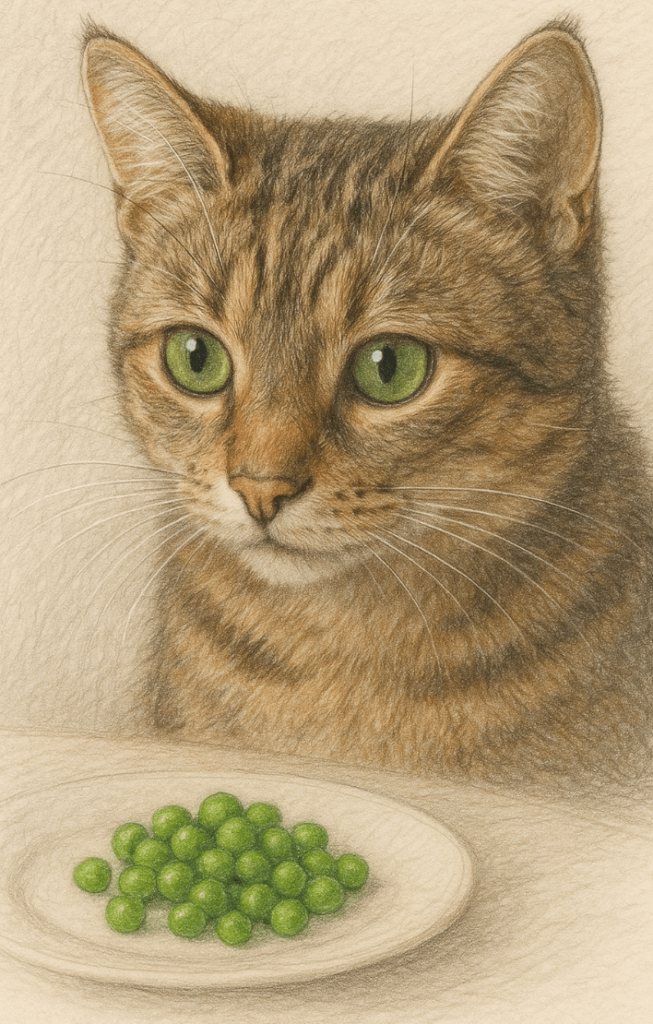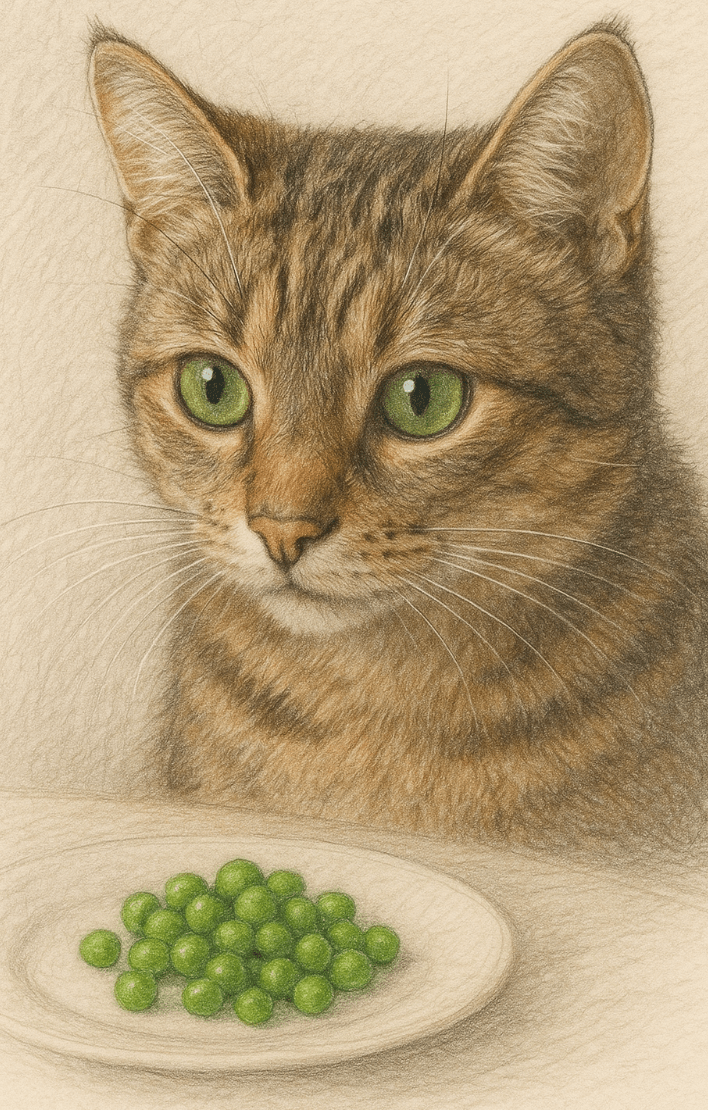Can Cats Eat Peas? A Guide to Feline Nutrition
When it comes to feeding our feline friends, many pet owners wonder whether human foods are safe for cats. One common question is, “Can cats eat peas?” Peas are a nutritious vegetable packed with vitamins and minerals, but not all human foods are suitable for cats. Understanding what’s safe and beneficial for your cat’s diet is essential to ensure their health and happiness. In this blog post, we’ll explore whether peas are a good addition to your cat’s meals, potential risks, and tips for incorporating them safely into their diet.
Are Peas Safe for Cats? Key Considerations
Peas can be a healthy treat for cats when given in moderation, but there are important factors to consider before adding them to your cat’s diet. Here’s what you need to know about feeding peas to your feline friend.
Rich in Nutrients:
Peas contain vitamins A, C, and K, as well as fiber and protein, which can benefit your cat’s overall health.Low in Calories:
Peas are low in calories, making them a safe option for cats that need to maintain or lose weight.Potential Allergies:
Some cats may have sensitivities or allergies to peas, so introduce them gradually and monitor for adverse reactions.Digestive Sensitivity:
Cats have delicate digestive systems; too many peas can cause gas, bloating, or diarrhea.Avoid Seasonings and Additives:
Plain peas are safe, but those cooked with salt, spices, or butter can harm your cat’s health.
By keeping these points in mind, you can determine whether peas are a suitable occasional treat for your cat.
Health Benefits of Peas for Cats
While cats are obligate carnivores and primarily need animal-based protein, peas can offer some nutritional benefits when fed sparingly. Here’s how peas can positively impact your cat’s health.
Supports Digestive Health:
The fiber in peas can aid digestion and help regulate bowel movements, especially in cats prone to constipation.Boosts Immune System:
Vitamins A and C in peas support a strong immune system, helping your cat fight off infections.Promotes Healthy Skin and Coat:
Vitamin K and antioxidants contribute to healthy skin and a shiny coat, reducing dryness and flakiness.Provides Plant-Based Protein:
While not a substitute for animal protein, peas can supplement your cat’s diet with additional amino acids.Encourages Hydration:
Fresh or lightly steamed peas contain water, which can help keep your cat hydrated.
These benefits make peas a nutritious option for cats when included as an occasional treat rather than a dietary staple.
Check this guide 👉Can Cats Eat Sardines? Best 7 Expert Tips!
Check this guide 👉Can Cats Eat Raspberries? Best 7 Expert Tips!
Check this guide 👉Can Cats Eat Lettuce? Best 7 Expert Tips!

Safe Ways to Feed Peas to Cats | Risks of Feeding Peas Incorrectly |
|---|---|
Plain, fresh peas (unseasoned) | Overfeeding leading to digestive upset |
Lightly steamed or mashed peas | Adding salt, spices, or butter |
Small amounts mixed with regular food | Feeding canned peas with added sugar |
Frozen peas (thawed and unsalted) | Allergic reactions or sensitivities |
Pea puree without additives | Choking hazard from large pieces |
How to Safely Introduce Peas to Your Cat’s Diet
Introducing new foods to your cat’s diet requires care and observation. Follow these steps to ensure peas are safe and enjoyable for your feline companion.
Start with Small Portions:
Offer just one or two peas at a time to see how your cat reacts before increasing the amount.Choose Plain Peas Only:
Avoid peas with added salt, spices, sauces, or flavorings, as these can be harmful to cats.Cook or Mash Them:
Steaming or mashing peas makes them easier for cats to chew and digest.Monitor for Reactions:
Watch for signs of allergies, such as vomiting, diarrhea, or itching, after introducing peas.Consult Your Veterinarian:
Always seek professional advice before making significant changes to your cat’s diet.
By following these guidelines, you can safely incorporate peas into your cat’s diet without compromising their health.
Signs Your Cat May Not Tolerate Peas
While many cats enjoy peas, some may not tolerate them well. Recognizing these signs early can prevent discomfort and health issues.
Vomiting or Nausea:
If your cat vomits after eating peas, it could indicate an intolerance or allergy.Diarrhea or Loose Stools:
Digestive upset is a common reaction to overfeeding or introducing new foods too quickly.Loss of Appetite:
Refusal to eat or disinterest in food may signal discomfort caused by peas.Excessive Gas or Bloating:
Peas can cause gas in some cats, especially if fed in large quantities.Itching or Skin Irritation:
Allergic reactions may manifest as excessive scratching, redness, or swelling around the face.
If you notice any of these symptoms, stop feeding peas and consult your veterinarian immediately.
Common Mistakes to Avoid When Feeding Peas to Cats
Feeding peas to your cat requires attention to detail to avoid unintended consequences. Here are some mistakes to steer clear of.
Overfeeding Peas:
Too many peas can upset your cat’s stomach and lead to nutrient imbalances in their diet.Using Canned Peas with Additives:
Many canned peas contain salt, sugar, or preservatives that are harmful to cats.Ignoring Allergy Signs:
Failing to recognize allergic reactions can result in prolonged discomfort for your cat.Feeding Large Pieces:
Whole peas may pose a choking hazard, especially for smaller cats or kittens.Assuming Peas Are Essential:
Peas are optional treats—not a required part of your cat’s diet.
Avoiding these pitfalls ensures your cat enjoys peas safely and without complications.
Alternative Vegetables Cats Can Enjoy
If your cat doesn’t take to peas, there are plenty of other vegetables they might enjoy. Here are some safe alternatives to consider.
Carrots (Cooked):
Rich in beta-carotene, carrots support eye health but must be cooked to soften them.Green Beans:
Low in calories and high in fiber, green beans make an excellent snack for cats.Pumpkin (Plain):
Pumpkin aids digestion and can help relieve constipation or diarrhea when served in small amounts.Zucchini (Steamed):
Zucchini is hydrating and easy to digest, making it a great occasional treat.Broccoli (Steamed):
Broccoli provides antioxidants and vitamins but should only be given in tiny portions.
These vegetables offer variety and nutrition while catering to your cat’s taste preferences.
Tips for Encouraging Picky Eaters to Try Peas
Some cats may turn up their noses at peas, but with creativity and patience, you can encourage them to give this veggie a try.
Mix with Wet Food:
Blend a small amount of mashed peas into your cat’s favorite wet food to mask the taste.Use Positive Reinforcement:
Reward your cat with praise or treats when they show interest in trying peas.Offer Variety:
Experiment with fresh, steamed, or pureed peas to find the texture your cat prefers.Make It Fun:
Use pea-sized portions as training rewards during play sessions to create positive associations.Be Patient:
Cats can be finicky, so don’t rush the process—let them explore new foods at their own pace.
With persistence and creativity, even picky eaters might come to appreciate the occasional pea treat.
Frequently Asked Questions About Cats and Peas
Can kittens eat peas?
Yes, in very small amounts, but always consult your vet before feeding peas to young cats.
Are frozen peas safe for cats?
Yes, as long as they’re thawed and free of additives like salt or preservatives.
How often can I feed my cat peas?
Peas should only be an occasional treat, no more than once or twice a week.
What other vegetables can cats eat?
Safe options include carrots, green beans, and pumpkin, but always serve them plain and in moderation.
Can peas replace meat in my cat’s diet?
No, cats are obligate carnivores and require animal-based protein as the foundation of their diet.
Balancing Treats and Nutrition for Your Cat
While peas can be a healthy and tasty treat for your cat, they should never replace the primary components of a balanced feline diet. Understanding your cat’s unique nutritional needs and monitoring their reaction to new foods ensures their well-being. By offering peas in moderation and prioritizing high-quality proteins, you can provide your cat with a varied and satisfying diet. Remember, every cat is different—so listen to their cues and consult your veterinarian for personalized advice. With proper care, you can keep your furry friend happy, healthy, and purring contentedly.
Cat Fever Treatment: Best 7 Expert Tips! Discover expert advice on identifying, managing, and treating fever in cats to ensure their quick recovery and well-being.
Understanding Meloxicam for Cats: Best 7 Expert Tips! Learn how to safely administer meloxicam, manage side effects, and ensure your cat's comfort with expert advice on feline pain relief.
Amoxicillin for Cat UTI: Best 7 Expert Tips! Discover safe usage, dosage guidelines, and expert advice on treating feline urinary tract infections effectively with amoxicillin.
Understanding Cat Cancer Treatment: Best 7 Expert Tips! Discover expert advice on managing feline cancer, from early detection to treatment options, ensuring your cat’s health and comfort.





